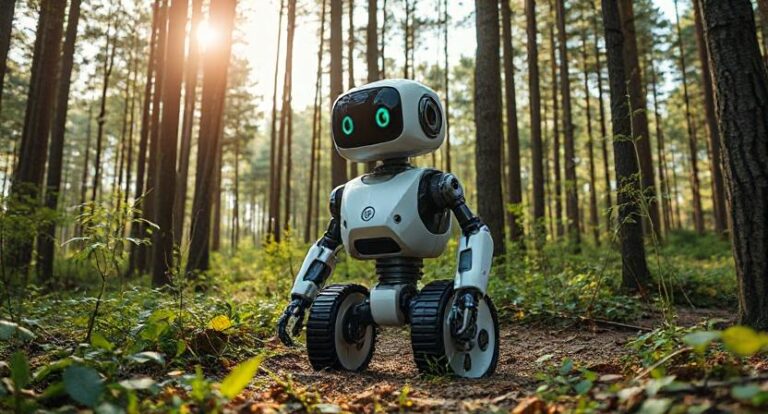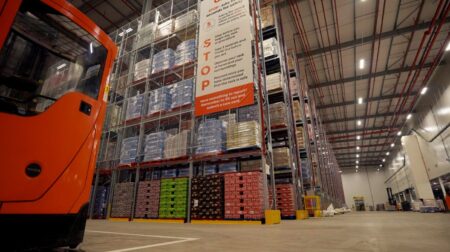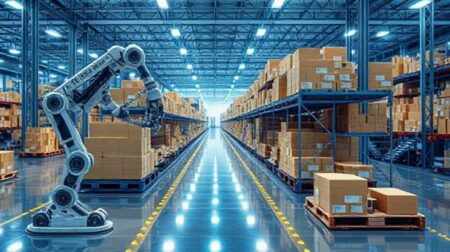From urban distribution hubs to cross-border freight, robotics and automation are proving critical in reducing costs and cutting carbon. John Thornton reports.
As pressure mounts on logistics operators to cut emissions and meet the UK’s 2035 internal combustion engine phase-out, robotics is fast emerging as a strategic enabler of supply chain decarbonisation – particularly in the often-overlooked stages of transport and fulfilment beyond the warehouse.
From automated last-mile delivery to robotised order collation and smart intralogistics, businesses are increasingly deploying robotics not only to drive cost efficiencies, but to eliminate carbon-intensive practices. Yet, adoption is still shaped more by economic pressures than environmental mandates – at least for now.
“Advanced analytics and robotics are reducing transport costs through better load fill, scheduling and rostering,” says Emile Naus, partner at consultancy BearingPoint and former head of logistics strategy at UK retailer M&S.
“Fully robotic deliveries such as those by Starship Technologies or Peykbot in Milton Keynes, and Waymo’s autonomous taxis in the USA, are starting to show how automation can streamline last-mile operations.”
These early deployments, while small in scale, highlight a crucial benefit of robotics: reducing waste around so-called “empty” miles. As delivery density increases, so too does the opportunity to consolidate orders through urban sortation centres or autonomous delivery hubs – many of which already use mobile robots to optimise operations.
BOT BYTE: 60% of logistics CEOs plan to invest in automation for sustainability and resilience within the next two years. Source: PwC Digital Operations Survey, 2024
“Electric fleets are common in cities for vans and small lorries, but heavy goods vehicle electrification remains difficult due to vehicle economics,” Naus adds. “Where robotics can help is in reducing unnecessary transport – minimising distance and emissions through better planning and collation.”
Reshoring and rethinking supply chains
For Marc Bouchet, senior investment associate at TDK Ventures, a corporate venture capital firm investing globally in early-stage tech startups, robotics is also key to reshaping the global footprint of logistics itself.
“Automation enables deglobalised manufacturing supply chains,” he explains. “By offsetting labour costs, robotics makes it feasible to manufacture closer to the customer, which shortens supply chains and reduces emissions from high-carbon freight modes like air.”
This shift has prompted growing interest in automating the “in-between” layers of logistics – the handovers between manufacturer, customs, port and distribution centre. “We’re backing start-ups automating these transitions with autonomous, electric vehicles. Eliminating both fuel and labour costs creates a compelling business case for decarbonised intralogistics.”
“Where robotics can help is in reducing unnecessary transport – minimising distance and emissions through better planning and collation” – Emile Naus, partner, BearingPoint, and former head of logistics strategy, M&S
Beyond transport, robotics also facilitates smarter energy use across production and logistics. Unlike human-shifted operations, robotic systems can run around the clock and align with renewable energy availability – reducing strain on the grid and improving carbon intensity.
Robotics aside, artificial intelligence (AI) platforms are increasingly critical in helping organisations track, manage and reduce carbon emissions – especially across Scope 3, which often accounts for the largest share of a company’s footprint. India-based start-up Fitsol, for example, recently raised US$1m in seed funding from Transition VC to enhance its AI platform Kyoto, which enables manufacturers to measure and reduce emissions across transport, packaging, warehousing and waste.
“Scope 3 emissions make up 70-90% of a company’s carbon footprint,” says Fitsol founder and CEO Anand Pathak. “We help manufacturers not just report emissions, but reduce them by implementing practical solutions across the supply chain.”
Takeaways for decision-makers
- Link automation to emissions data: Use robotics in combination with AI to target Scope 3 hotspots across logistics
- Adopt early, pilot smart: Prioritise scalable use cases in intralogistics, urban delivery and fleet orchestration
- Collaborate strategically: Partner with energy providers, software vendors and automation specialists to accelerate innovation
- Upskill your workforce: Train staff to supervise, interpret
and maintain autonomous systems- Prepare for compliance: Align automation strategies with upcoming emissions reporting standards
Fitsol claims to have delivered 15-20% cost savings across its carbon reduction projects, working with clients such as JK Tyre, Hindware and Penguin Random House India, and serving suppliers to Mahindra, Suzuki and OLA Electric. The company aims to decarbonise 500 million tonnes of supply chain emissions within the next two years, with a focus on India and the Middle East.
Platforms such as Kyoto offer complementary tools to robotics by enabling real-time emissions visibility, ROI modelling, and optimisation of green procurement and logistics decisions – critical functions as firms prepare for stricter regulatory and disclosure requirements.
Scaling challenges
These developments reflect a broader industry shift identified in the sixth edition of the DHL Logistics Trend Radar. This report singles out decarbonisation and robotics as two of the most impactful trends set to shape the logistics sector over the next decade.
As consumer and regulatory pressures intensify, DHL forecasts increased adoption of indoor mobile and stationary robots to improve productivity and reduce environmental impact.
This strategic convergence is also reinforced by recent market data: a 2024 report by Precedence Research projects the global logistics automation market will surpass US$133bn by 2032, driven by a blend of decarbonisation mandates and cost competitiveness.
Examples of robotics driving carbon reduction in logistics
Starship Technologies – Milton Keynes, UK
Since launching in 2018, Starship’s autonomous delivery robots have replaced more than 280,000 car journeys, avoiding more than 500,000 miles of emissions-heavy transport. Environmental savings include 137 tonnes of CO₂, 22kg of NOx, and more than 35kg of particulate matter. By 2030, emissions reductions are forecast to exceed 46,000 tonnes of CO₂.Oxa – Sunderland, UK
In partnership with Nissan and Vantec, Oxa has deployed 5G-enabled autonomous vehicles to transport car parts across private industrial sites. The initiative supports Sunderland’s smart city ambitions by demonstrating scalable, low-carbon logistics in a controlled environment.Waymo – San Francisco, USA
Waymo’s driverless taxi service has clocked more than 25 million miles with markedly fewer accidents and claims than human drivers. Reduced collisions help improve traffic flow and decrease emissions linked to idling and congestion.
Furthermore, with the European Union’s Corporate Sustainability Reporting Directive (CSRD) taking effect in 2025, large organisations will be obligated to report on Scope 1, 2 and 3 emissions – a development expected to accelerate adoption of AI and robotics tools capable of supporting transparent emissions reporting and operational decarbonisation.
Despite these advantages, scaling robotics for decarbonisation still faces real-world barriers – particularly in the UK. “There are regulatory concerns around safety in mixed environments, where robotic and conventional vehicles coexist,” warns Naus. “While autonomy technology has advanced, widespread real- life deployment requires further development – especially in public spaces.”
BOT BYTE: AI-powered route and load optimisation tools could reduce logistics-related emissions by up to 30%. Source: McKinsey & Company
Cultural readiness and user interface design also matter. “It’s not about moving the vehicle; it’s about delivering the product,” he adds. “That human interaction layer is still critical.”
Another underappreciated challenge is workforce transformation. As automation scales, logistics providers must invest in retraining and upskilling staff to work alongside robotics – from supervising autonomous vehicles to maintaining AI-driven platforms. Bridging this human-tech interface is essential for both operational continuity and stakeholder buy-in.
Financial constraints are another major factor. “Right now, ROI drives procurement decisions more than carbon metrics,” Naus concedes. “That said, advanced analytics can cut both costs and emissions, so the sustainability benefit becomes a co-driver.”
The investor lens
From the investor side, supply chain decarbonisation is regarded as a valuable by-product of well-executed automation, not the sole driver.
“Successful robotics start-ups don’t overpromise,” Bouchet notes. “They focus on narrow customer segments and use real-world deployments to collect data. That data then improves performance and builds a scalable, differentiated product.”
Strategic partnerships – with logistics providers, component suppliers and energy firms – can accelerate market access while enhancing product performance. But Bouchet warns of pitfalls: “There’s a risk when strategic investors come from an anticompetitive mindset. The best partnerships let startups move fast without interference.”
Ultimately, Bouchet urges early-stage robotics firms to prioritise cost, performance, and use-case clarity. “Positive climate impact and social benefit are real – but they come from solving a specific customer problem efficiently. Get the economics right, and the emissions savings will follow.”
With the UK’s ICE ban drawing closer, robotics is unlikely to be a silver bullet – but it can be a powerful tool in a broader decarbonisation strategy.
“Robotics will supplement the shift,” Naus concludes. “It helps limit unnecessary transport, optimise operations and reduce emissions without compromising service. That’s a win-win – for the business, the customer and the climate.”
As robotics and automation continue to mature across logistics, the future of green supply chains may be more intelligent and sustainable than ever before.
This article originally appeared in the May 2025 issue of Robotics & Automation Magazine. Read here!








